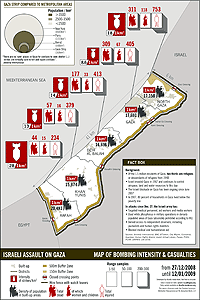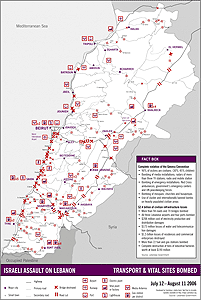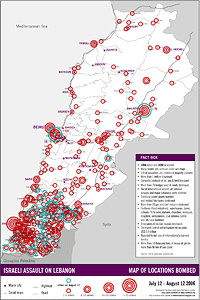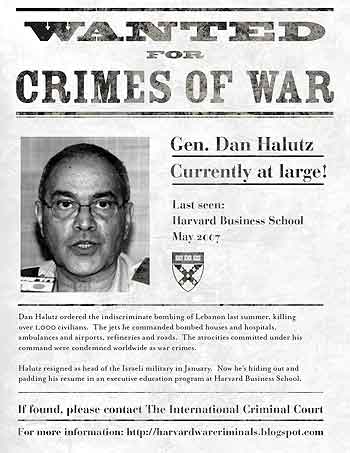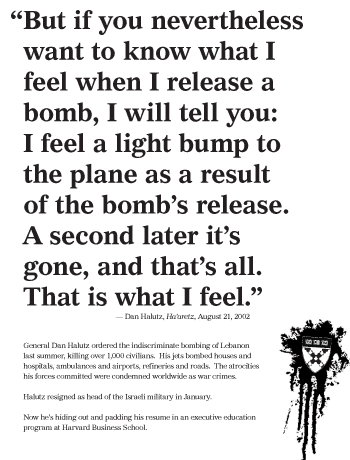lebanon
Information Design for Advocacy: Beirut Workshops
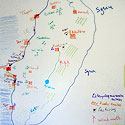
Civil society in Lebanon is blossoming. The number of registered NGOs has increased dramatically in recent years and as advocacy campaigns become more sophisticated, there is a growing appetite for learning new techniques for conveying ones messages. I was invited by the US State Department Speaker Specialist Program to work with the Social Media Exchange (SMEX) in Beirut to conduct a week of workshops for local and international NGO staff on visual thinking and information design for advocacy.
Building on my work and my 2008 booklet Visualizing Information for Advocacy: An Introduction to Information Design, I devised three day-long workshops which were announced as follows:
Continue reading "Information Design for Advocacy: Beirut Workshops" »
Beirut: Mapping Security
Beirut: Mapping Security is an ongoing research work and a newspaper publication edited by Mona Fawaz, Ahmad Gharbieh and Mona Harb, developed and assembled within the international network DIWAN.
“Armed conflict normalizes the presence of visible so-called security measures in the form of barricades, road blocks or army personnel in the everyday life of the city. This is perhaps one of the legacies of the Lebanese civil war (1975–1990), the Israeli occupation of parts of South Lebanon (since 1978), and the ongoing Arab Israeli conflict that have all marked Lebanon’s recent history. In Beirut security associated with these conflicts, whether in the form of protecting key political figures and/or preventing inter-communal violence, has been a latent aspect of the cityscape which heavily affects people’s everyday practices and movements. The recent development of a network of high-end shopping and entertainment facilities in Beirut has established a new layer of security, this time intended to protect the rich.
Our aim in this project was to initiate a public debate about the normalization of security as an element of urban governance and how this new narrative of threats and fear profoundly alters everyday practices.”

Solidarity Maps
The maps below visualize some of the impact of Israeli attacks on civilians and civilian infrastructure in Lebanon and the Gaza Strip. About the designers:
“We are a group of Lebanese a group of Lebanese, Palestinian, and other activists who have worked together previously, mainly doing media and mapping work during the summer 2006 Israeli attack on Lebanon, and some of us later on advocacy and design for the reconstruction of Nahr el-Bared refugee camp. We have among us designers, architects, researchers, media people, and many other random activists. Although we are not an organised body or politically affiliated with a specific group, we are all pro-Palestinian.”
Gaza - Map of Bombing Intensity & Casualties, December 27, 2008—January 12, 2009
Lebanon - transport & vital sites bombed, July 12—August 12, 2006
Israeli Assault on Lebanon, July 12—August 12, 2006
Wanted at Harvard
A flyer I designed appears on the front page of today’s edition of the Ma’ariv, the second largest newspaper in Israel.
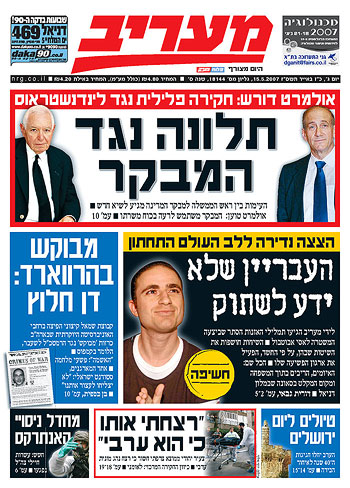
Here’s a close up:
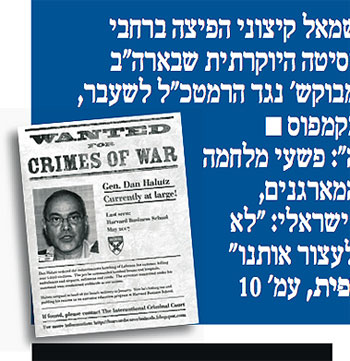
The flyer is for a campaign by Alliance for Justice in the Middle East, a student group at Harvard University.
The text calls attention to the enrollment of former Israeli general Dan Halutz in the Advanced Management Program at Harvard Business School. Halutz oversaw the bombing of Lebanon in the summer of 2006. See his dossier here.
And he’s not the first accused war criminal enrolled by Harvard. See a short list of bios on the AJME site. The AJME is campaigning to establish a set of practices to screen for war criminals and serious human rights abusers as part of its admissions and hiring policies.
The campaign was relatively modest to achieve such front page coverage. The group set up a free web site on blogspot. They printed up the flyer and handed it out on campus. They also sent out a press release about the campaign, which resulted in front page coverage.
Here’s the full article in Hebrew on the Ma’ariv web site and AJME’s English translation of it.
Click below for a larger version of the flyer:
For contrast, see another iteration below. I think it’s a little more evocative, but maybe less direct.
Update: The flyer is featured online at Time and Al Jazeera. See other coverage of the campaign.
Design against Corruption
Let’s say the president of your country is corrupt. Let’s just say.
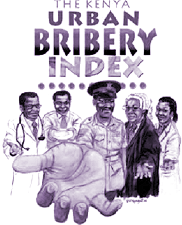 The legislature is corrupt. The court system, police, and military are all corrupt. The city officials? The big businesses? They’re corrupt, too.
The legislature is corrupt. The court system, police, and military are all corrupt. The city officials? The big businesses? They’re corrupt, too.
They misuse their power. They thrive on favoritism and get rich on kickbacks while the rest the country slowly starves. What do you do?
Replacing one individual with another doesn’t change the broader system or take away any of the incentives for corruption.
So how do you reduce corruption throughout a given system?
Transparency International is a network of independent national chapters that work to curb “both the supply and demand of corruption.”
Some of the strategies they use are described in their annual Corruption Fighters’ Tool Kit. The manual is just one of the ways the TI chapters share ideas with each other and offer their experience to the world at large. In addition to the hard work of organizing and building coalitions, many of the corruption-reducing strategies incorporate graphic and interactive design. Some of them include:
- Awareness Raising - TI Korea produced posters, videos, and CD-ROMs to disseminate information about the effects of corruption and local initiatives against it. TI Morocco indexed, cataloged, and analyzed incidents of corruption that appeared in the media, published their findings and will soon make this database accessible online. As part of its campaign to promote access to information in Romania and the Federal Republic of Yugoslavia, TI Romania produced and actively updated a Web site on the issue, printed a pocket guide to inform citizens about their rights, and designed posters and flyers with their Serbian partner organization to promote the idea of free access to public information and raise public awareness about the project. The posters were printed in Romanian and Serbian and distributed through an international network of NGOs and local government offices.
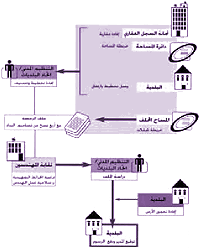 Monitoring Election Campaigns - TI Chile developed and distributed a report card to tabulate the quantity, subject, and context of media coverage devoted to each candidate. They distributed their analysis and data on CD-ROM.
Monitoring Election Campaigns - TI Chile developed and distributed a report card to tabulate the quantity, subject, and context of media coverage devoted to each candidate. They distributed their analysis and data on CD-ROM.- Opening Processes - Activists in Lebanon determined that construction was the most corrupt sector in the country and designed a manual on how to acquire a construction permit, “one of the most difficult bureaucratic transactions in the Lebanese administration.” In response to the government’s lack of reliable information on the process of public procurement, TI Ecuador created an Web site to inform the public (and the private sector), make government forms available, display past and current bidding processes, and host a forum for discussion and analysis.
- Implementing Diagnostics - TI chapters in Bangladesh, Kenya, and Japan developed surveys and metrics for corruption in government and the private sector that they then published locally. TI Lithuania created a database of institutional and geographic aspects of corruption and published a “Map of Corruption” as a foundation for future campaign work.
Posters in Beirut

From the Association Typographie Internationale conference in Vancouver this weekend, a description of one presentation:
“A strong plurality of visual typographic styles and rhetorical strategies emerged after the war in Beirut. Lebanese are so sensitive now about the ethnic hatred which sparked off the war that they have been reluctant to speak up about it, yet they are tagging the streets of the city with slogans as a means of expression.
In this presentation Yasmine Taan analyses how ‘untrained designers/typographers’ have chosen the appropriate ‘typefaces’ whose diverse styles powerfully reflect the context of their messages, giving voice to the political aspirations of the inhabitants.”
A preface to this can be seen in the images of political posters in the American University of Beirut Jafet Library Poster Collection.
The posters were collected from the 1960s through the 1980s, before and during the war, from their original sources and from the American University of Beirut campus where they were posted. The collection covers two main topics: the Palestinian Question, and Lebanon and the Lebanese Civil War.
A few images are online, organized as follows:


